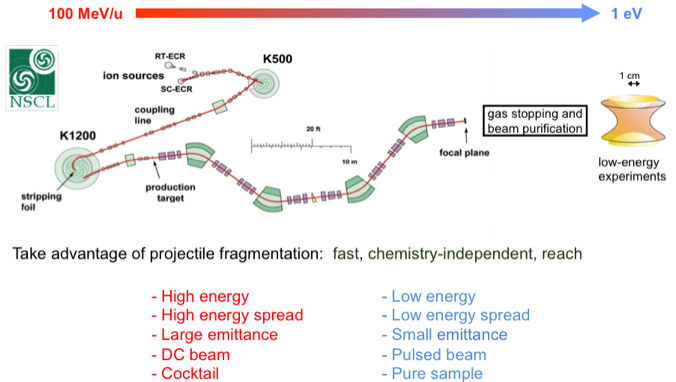Rare isotopes are produced using the NSCL's Coupled Cyclotron Facility (CCF). A variety of ion sources are used to produce a beam of stable ions that are injected into the first cyclotron (K500). They are accelerated and extracted through the coupling line and injected into the larger cyclotron (K1200), passing through a stripping foil which removes electrons, increasing the ions' charge state. The ions are accelerated to about 100 MeV/u, or about one-third of the speed of light, before being extracted and passing through the production target.
The production target is a thin metal foil, typically beryllium, where the fast, stable ion beam has enough energy such that the nuclei from the ion beam and target can react and create isotopes that don't naturally exist on Earth. However, many different isotopes are produced simultaneously, but experimenters normally want only one species at a time. So after production the beam is filtered through a series of magnets, the A1900 fragment separator, where the unwanted beam components are separated out.
The production target is a thin metal foil, typically beryllium, where the fast, stable ion beam has enough energy such that the nuclei from the ion beam and target can react and create isotopes that don't naturally exist on Earth. However, many different isotopes are produced simultaneously, but experimenters normally want only one species at a time. So after production the beam is filtered through a series of magnets, the A1900 fragment separator, where the unwanted beam components are separated out.

Projectile fragmentation is a very flexible rare isotope production method, but the resultant beam properties, given above in red, are not optimal for low-energy, high-precision experiments, such as Penning trap mass spectrometry. These types of experiments require the beam properties listed above in blue. The first step in preparing the beam is to reduce the beam energy by a factor greater than 100,000,000! This is accomplished by thermalizing the ions in a gas using so-called gas catchers.